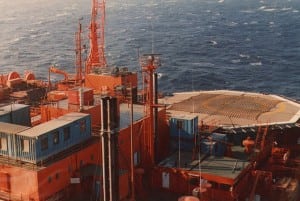Latest News
[Via Satellite 05-13-2014] After recording more than $30 million in new high-end satellite network deployments, ITC Global is confident that the oil and gas sector is on a long-term upswing for satellite connectivity. New sales counted for roughly half of its business during the first quarter of 2014, of which the plurality was in West Africa’s offshore energy market.
“I think energy is about to undergo a renaissance in embracing the technology and not engineering around it,” Joe Spytek CEO of ITC Global, told Via Satellite.
ITC Global provides satellite communications to remote industrial markets. While commenting on the increasing activity in oil and gas, Spytek said he expects the industry will follow a pattern he saw in mining, where the pace of growth was, for some time, quite fast.
“They moved toward automation long before energy, but … it appears that trend is finally happening in energy. [There are] rigs that can survive on 768 Kbps or maybe 1 to 2 Mbps, but we have not sold a 768 Kbps service to a miner in five years. We sell 10 Mbps, 20 Mbps and we have one that has 160 Mbps across a couple of mines in Siberia. Just in terms of raw throughput, I think that is going to happen in the energy space,” he said.
ITC Global is investing in more mature markets as well. In January, the company established a regional headquarters in Houston, TX, and in February it opened an office in Aberdeen, Scotland, near the North Sea. Spytek said decision-making by producers, drillers and other energy sector officials appears to be moving east. New sites are also appearing in more difficult to reach parts of the world.
“The Gulf of Mexico is coming back [and] Brazil is slowing down a little, but you wouldn’t believe the activity we see in Russia, the CIS countries, the Northwest shelf of Australia and the Indonesian waters,” said Spytek. “The latter is a difficult region to deal with because the nearest capital city is Perth, and that’s a long way away … therefore satellite communications becomes more and more critical.”
New deployments have included networks that connect offshore facilities to operation centers and quick deployment systems for short-duration projects.
One such West African deployment involved setting up two large-scale 4.8-meter Earth stations at local shore bases, along with a significant upgrade to 15 existing offshore satellite terminals. In the future Spytek believes oil and gas customers will look to move more of their operations further out from the coast.
“They are finding that it’s cheaper to put a lot of these assets offshore,” he said. “Not to build an onshore [Liquefied Natural Gas] (LNG) facility anymore, but have a floating LNG plant. That vessel will cost a couple billion dollars to build, but it will go on station and sit there for 10, 15 or 20 years in some cases. In that case, the only way to service that vessel is via satellite. In short, I think that is going to be a trend that continues.”
For ITC Global, Spytek said the company’s next goal is to create fully redundant remote systems for offshore, difficult to reach locations. With the exception of select antenna spares that cannot be run in a fully redundant mode, all of the company’s below deck products will be completely redundant for all customers. Now that oceans have greater access to satellite capacity, redundancy and other services can be offered simultaneously.
“The technology and reliability have improved so much,” said Spytek. “It has always been availability over throughput, but I think now you can have both, and now that you can reliably, customers will, in fact, go for both.”
Get the latest Via Satellite news!
Subscribe Now